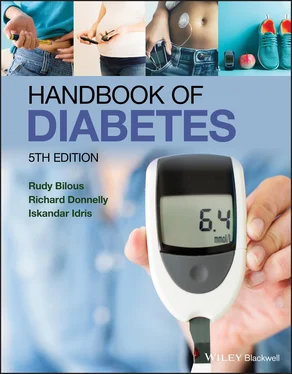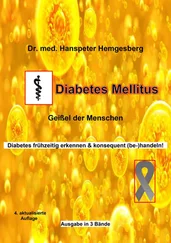Library of Congress Cataloging‐in‐Publication Data
Names: Bilous, Rudy W., author. | Donnelly, Richard, 1960‐ author. | Idris, Iskandar, author.
Title: Handbook of diabetes / Rudy Bilous, Richard Donnelly, Iskandar Idris.
Description: Fifth edition. | Hoboken, NJ : Wiley‐Blackwell, [2021] | Includes bibliographical references and index.
Identifiers: LCCN 2020051205 (print) | LCCN 2020051206 (ebook) | ISBN 9781118976043 (paperback) | ISBN 9781118975992 (adobe pdf) | ISBN 9781118975978 (epub)
Subjects: MESH: Diabetes Mellitus | Diabetes Complications
Classification: LCC RC660.4 (print) | LCC RC660.4 (ebook) | NLM WK 810 | DDC 616.4/62–dc23
LC record available at https://lccn.loc.gov/2020051205LC ebook record available at https://lccn.loc.gov/2020051206
Cover Design: Wiley
Cover Images: (top, left to right) © BSIP/Getty Images, © artursfoto/Getty Images, © Click_and_Photo/Getty Images, © Goffkein / Adobe Stock Photo, (main) © vgajic/Getty Images
It is more than 10 years since the last edition and much has changed in diabetes understanding and therapy. Advances in diabetes technologies such as continuous glucose monitoring have made the use of closed‐loop insulin infusion devices commonplace in many countries. New therapies for type 2 diabetes have led to the concept of personalised management algorithms for patients based upon individual circumstances such as age, weight and presence of complications or comorbidities. Large randomised trials of these treatments have shown benefit in terms of reduction of cardiovascular and renal risk. Diabetic retinopathy is no longer the leading cause of blindness in the working age population in the UK. Bariatric surgery and very low calorie diets have demonstrated the reversibility of type 2 diabetes.
Some things are sadly the same, however, such as the seemingly inexorable rise in prevalence, with the 2019 global figures already exceeding the 2025 predictions of the last edition. Others have fallen short of initial promise, such as islet cell transplantation, and while genetic research into the causes of diabetes has increased our understanding it has not yet been translated into new treatments.
This latest version of the Handbook has been revised and updated incorporating all of these developments and more, and there are new chapters on Cancer and Liver disease. We have tried to maintain the standards and ethos of previous editions. References are again selective but focus on reviews that are freely available wherever possible; key guidance from NICE, SIGN, ADA and other specialist bodies is also included.
Iskandar Idris is a new member of the editorial team and we would like to thank Alistair Lumb for his contribution to the chapters on type 1 diabetes treatment and psychological problems.
The team at Wiley have been notable for their patience. We would like to thank Priyanka Gibbons, Anupama Srikanth, and Jennifer Seward. Their forbearance during the long gestation of this edition is much appreciated. Any errors of commission or omission are, of course, the responsibility of the editors.
The goal with this latest edition is to continue to provide a useful desktop reference for all involved in providing care to people with diabetes.
Rudy BilousRichard DonnellyIskandar Idris
Key to the boxes
KEY POINTS
These points summarise important learning topics, things to remember and/or areas that are sometimes misunderstood by healthcare professionals.
This is a typical case summary that illustrates a number of learning topics from the chapter.
These are often major trials underpinning the evidence base for clinical practice and decision‐making in the area.
Websites that contain further information, practice guidelines and/or learning topics to supplement the information in the chapter.
Published reviews, original research or meta‐analyses relevant to the chapter.
Part 1 Introduction to diabetes
Chapter 1 Introduction to diabetes
KEY POINTS
Diabetes is common, and its incidence is rising.
Type 2 diabetes is by far the most common accounting for 85–95% of cases.
Complications in the microvasculature (eye, kidney and nerve) and the macrovasculature are responsible for considerable morbidity and excess mortality.
Mortality from some complications is decreasing but absolute numbers for many are still rising.
Diabetes mellitus is a condition of chronically elevated blood glucose concentrations which give rise to its main symptom of passing large quantities of sweet–tasting urine ( diabetes from the Greek word meaning ‘a siphon’, as the body acts as a conduit for the excess fluid, and mellitus from the Greek and Latin for honey). The fundamental underlying abnormality is a net (relative or absolute) deficiency of the hormone insulin. Insulin is essentially the only hormone that can lower blood glucose.
There are two main types of diabetes: type 1 is caused by an autoimmune destruction of the insulin‐producing β cell of the islets of Langerhans in the pancreas (absolute deficiency); and type 2 is a result of both impaired insulin secretion and resistance to its action – often secondary to obesity (relative deficiency).
The precise level of blood glucose that defines diabetes has been revised several times and is covered in more detail in Chapter 3. Diabetes is common and is becoming more common. In absolute numbers, globally there are 463 million people aged 20–79 with known diabetes in 2019, projected to rise to 700 million in 2045. Alarmingly it is thought that there are almost as many again with undiagnosed diabetes. World‐wide, age‐adjusted prevalence is set to rise from 9.3 to 10.9% in 2045. The numbers of those with impaired glucose tolerance are equally startling with a prevalence of 7.5% in 2019, projected to rise to 8.6% in 2045 ( Figure 1.1). The relative proportions of type 1 to type 2 vary from 15 : 85% for Western populations to 5 : 95% in developing countries.
It is the short‐ and long‐term complications of diabetes which make it a major public health problem. Absolute deficiency of insulin leads to ketoacidosis and coma with an appreciable mortality even in the UK and other Western countries. Hyperglycaemic hyperosmolar state is less common but remains an equally serious problem for people with type 2 diabetes (see Chapter 12).
Long‐term hyperglycaemia affects the microvasculature of the eye, kidney, and nerve as well as the larger arteries, leading to accelerated atherosclerosis. Diabetes is the most common cause of blindness in those of working age, the most common single cause of end‐stage renal failure worldwide, and the consequences of neuropathy and peripheral vascular disease make it the most common cause of non‐traumatic lower limb amputation. Diabetes and its complications are estimated to account for 11.3% of all cause mortality in adults aged 20–79 years in 2019 and nearly 50% of these are in people of working age (< 60 years). Mortality from ischaemic heart disease and stroke is 2–4‐fold higher than in the age‐ and sex‐matched non‐diabetic population ( Figure 1.2). These relative rates have not substantially changed since the last edition, although, encouragingly, mortality rates from acute myocardial infarction and hyperglycaemic crises have reduced, at least in the USA and Sweden ( Figure 1.3). Because of the increasing numbers of people with diabetes, however, absolute numbers experiencing stroke, amputation, and end stage renal disease are increasing with massive associated financial costs. In 2019 the IDF estimates total diabetes healthcare expenditure will be US$760 billion and predicts that this will rise to US$ 825 billion in 2030 and US$ 845 billion by 2045 ( Figure 1.4).
Читать дальше












